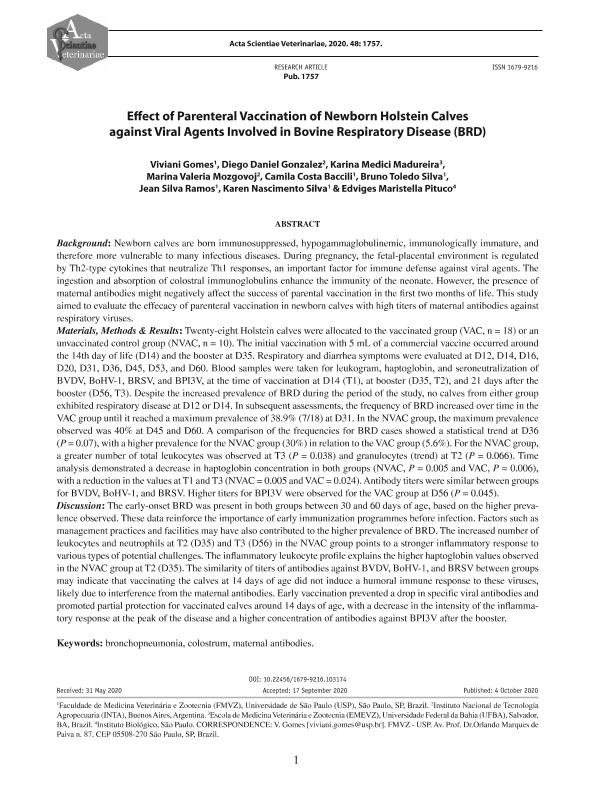Mostrar el registro sencillo del ítem
dc.contributor.author
Gomes, Viviani
dc.contributor.author
Gonzalez, Diego Daniel

dc.contributor.author
Medici Madureira, Karina
dc.contributor.author
Mozgovoj, Marina Valeria

dc.contributor.author
Costa Baccili, Camila
dc.contributor.author
Toledo Silva, Bruno
dc.contributor.author
Silva Ramos, Jean
dc.contributor.author
Nascimento Silva, Karen
dc.contributor.author
Maristella Pituco, Edviges
dc.date.available
2021-11-04T13:39:04Z
dc.date.issued
2020-10
dc.identifier.citation
Gomes, Viviani; Gonzalez, Diego Daniel; Medici Madureira, Karina; Mozgovoj, Marina Valeria; Costa Baccili, Camila; et al.; Effect of parenteral vaccination of newborn holstein calves against viral agents involved in bovine respiratory disease (BRD); Universidade Federal do Rio Grande do Sul; Acta Scientiae Veterinariae; 48; 1757; 10-2020; 1-9
dc.identifier.issn
1678-0345
dc.identifier.uri
http://hdl.handle.net/11336/145969
dc.description.abstract
Background: Newborn calves are born immunosuppressed, hypogammaglobulinemic, immunologically immature, and therefore more vulnerable to many infectious diseases. During pregnancy, the fetal-placental environment is regulated by Th2-type cytokines that neutralize Th1 responses, an important factor for immune defense against viral agents. The ingestion and absorption of colostral immunoglobulins enhance the immunity of the neonate. However, the presence of maternal antibodies might negatively affect the success of parental vaccination in the first two months of life. This study aimed to evaluate the effecacy of parenteral vaccination in newborn calves with high titers of maternal antibodies against respiratory viruses. Materials, Methods & Results: Twenty-eight Holstein calves were allocated to the vaccinated group (VAC, n = 18) or an unvaccinated control group (NVAC, n = 10). The initial vaccination with 5 mL of a commercial vaccine occurred around the 14th day of life (D14) and the booster at D35. Respiratory and diarrhea symptoms were evaluated at D12, D14, D16, D20, D31, D36, D45, D53, and D60. Blood samples were taken for leukogram, haptoglobin, and seroneutralization of BVDV, BoHV-1, BRSV, and BPI3V, at the time of vaccination at D14 (T1), at booster (D35, T2), and 21 days after the booster (D56, T3). Despite the increased prevalence of BRD during the period of the study, no calves from either group exhibited respiratory disease at D12 or D14. In subsequent assessments, the frequency of BRD increased over time in the VAC group until it reached a maximum prevalence of 38.9% (7/18) at D31. In the NVAC group, the maximum prevalence observed was 40% at D45 and D60. A comparison of the frequencies for BRD cases showed a statistical trend at D36 (P = 0.07), with a higher prevalence for the NVAC group (30%) in relation to the VAC group (5.6%). For the NVAC group, a greater number of total leukocytes was observed at T3 (P = 0.038) and granulocytes (trend) at T2 (P = 0.066). Time analysis demonstrated a decrease in haptoglobin concentration in both groups (NVAC, P = 0.005 and VAC, P = 0.006), with a reduction in the values at T1 and T3 (NVAC = 0.005 and VAC = 0.024). Antibody titers were similar between groups for BVDV, BoHV-1, and BRSV. Higher titers for BPI3V were observed for the VAC group at D56 (P = 0.045). Discussion: The early-onset BRD was present in both groups between 30 and 60 days of age, based on the higher prevalence observed. These data reinforce the importance of early immunization programmes before infection. Factors such as management practices and facilities may have also contributed to the higher prevalence of BRD. The increased number of leukocytes and neutrophils at T2 (D35) and T3 (D56) in the NVAC group points to a stronger inflammatory response to various types of potential challenges. The inflammatory leukocyte profile explains the higher haptoglobin values observed in the NVAC group at T2 (D35). The similarity of titers of antibodies against BVDV, BoHV-1, and BRSV between groups may indicate that vaccinating the calves at 14 days of age did not induce a humoral immune response to these viruses, likely due to interference from the maternal antibodies. Early vaccination prevented a drop in specific viral antibodies and promoted partial protection for vaccinated calves around 14 days of age, with a decrease in the intensity of the inflammatory response at the peak of the disease and a higher concentration of antibodies against BPI3V after the booster.
dc.format
application/pdf
dc.language.iso
eng
dc.publisher
Universidade Federal do Rio Grande do Sul

dc.rights
info:eu-repo/semantics/openAccess
dc.rights.uri
https://creativecommons.org/licenses/by/2.5/ar/
dc.subject
BRONCHOPNEUMONIA
dc.subject
COLOSTRUM
dc.subject
MATERNAL ANTIBODIES
dc.subject.classification
Ciencias Veterinarias

dc.subject.classification
Ciencias Veterinarias

dc.subject.classification
CIENCIAS AGRÍCOLAS

dc.title
Effect of parenteral vaccination of newborn holstein calves against viral agents involved in bovine respiratory disease (BRD)
dc.type
info:eu-repo/semantics/article
dc.type
info:ar-repo/semantics/artículo
dc.type
info:eu-repo/semantics/publishedVersion
dc.date.updated
2021-09-07T15:17:33Z
dc.identifier.eissn
1679-9216
dc.journal.volume
48
dc.journal.number
1757
dc.journal.pagination
1-9
dc.journal.pais
Brasil

dc.journal.ciudad
Porto Alegre
dc.description.fil
Fil: Gomes, Viviani. Universidade de Sao Paulo; Brasil
dc.description.fil
Fil: Gonzalez, Diego Daniel. Instituto Nacional de Tecnologia Agropecuaria. Centro de Investigacion En Ciencias Veterinarias y Agronomicas. Instituto de Virologia E Innovaciones Tecnologicas. - Consejo Nacional de Investigaciones Cientificas y Tecnicas. Oficina de Coordinacion Administrativa Pque. Centenario. Instituto de Virologia E Innovaciones Tecnologicas.; Argentina
dc.description.fil
Fil: Medici Madureira, Karina. Universidade Federal da Bahia; Brasil
dc.description.fil
Fil: Mozgovoj, Marina Valeria. Instituto Nacional de Tecnologia Agropecuaria. Centro de Investigacion En Ciencias Veterinarias y Agronomicas. Instituto de Virologia E Innovaciones Tecnologicas. - Consejo Nacional de Investigaciones Cientificas y Tecnicas. Oficina de Coordinacion Administrativa Pque. Centenario. Instituto de Virologia E Innovaciones Tecnologicas.; Argentina
dc.description.fil
Fil: Costa Baccili, Camila. Universidade de Sao Paulo; Brasil
dc.description.fil
Fil: Toledo Silva, Bruno. Universidade de Sao Paulo; Brasil
dc.description.fil
Fil: Silva Ramos, Jean. Universidade de Sao Paulo; Brasil
dc.description.fil
Fil: Nascimento Silva, Karen. Universidade de Sao Paulo; Brasil
dc.description.fil
Fil: Maristella Pituco, Edviges. Instituto Biológico; Brasil
dc.journal.title
Acta Scientiae Veterinariae

dc.relation.alternativeid
info:eu-repo/semantics/altIdentifier/doi/http://dx.doi.org/10.22456/1679-9216.103174
Archivos asociados
